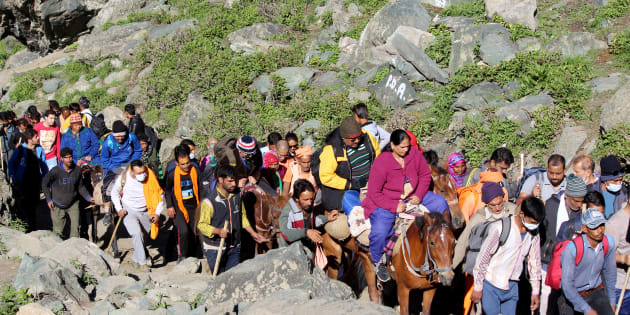
Bhagya Mani, a poor Maharashtrian woman, was admitted in the hospital with multiple fractures. "We were in the bus when firing was on from all the sides" she said from her bed at the Anantnag district hospital. She was luckier than some of her co-travellers.
On 10 July around 8.30 pm, Pakistan-based Lashkar-e-Taiba gunmen attacked a police party and later a bus carrying 56 Hindu pilgrims to Amarnath in Kashmir. Seven were killed, and over 20 injured. This attack has left the entire nation in a state of shock, with people across the spectrum condemning the attacks.
A timed attack
The timing of the attack does not seem to be random. Two possible explanations suggest this.
First, the pilgrims were targeted on the 1st Monday of the month of Shravan—one of the holiest days for Hindu pilgrims. It's when they visit the holy shrine of Amarnath, dedicated to Lord Shiva.
Cultural minorities have to feel safe for syncretism to have meaning. The Valley has to get back to its shared culture before it becomes impossible to do so.
Second, the attack appeared to have been timed to overlap the first death anniversary of militant leader Burhan Wani. His death had caused widespread anger amongst separatists in the Valley. The Monday attack could be seen as retribution for his death.
There was a surge in the number of pilgrims to Amarnath from 98,000 in 1999 to a record number of 6.4 lakh in 2011. But now this number has drastically reduced to 2.15 lakh registrations for 2017. This is primarily due to unrest and conflict in the Valley. Post Burhan's encounter, J&K has witnessed a 45% increase in terrorism-related deaths and a 164% rise in civilian deaths, according to the South Asian Terrorism Portal.
The pilgrim's view
Despite the hostile environment, lakhs of pilgrims risk their lives and flock to Amarnath every year. Yatris also face numerous physical challenges while trekking. The pilgrims believe that the Amarnath cave is where Lord Shiva is believed to have elucidated the secret of eternal life to his wife Parvati. This pilgrimage is believed to be a means of transcending the material world and attaining liberation.
An age-old tradition
To understand the true significance of this attack, we have to see it in the context of the long history of the Amarnath yatra. Pop culture credits Buta Malik, a Muslim Shepherd, for discovering the Amarnath cave in 1850s. However, other references establish that the pilgrimage has been going on for over a thousand years. The earliest reference to Amarnath can be seen in Nilamata Purana, a 6th-century text on the cultural life of early Kashmiris. In historical chronicles such as Kalhana's Rajatarangini and its sequel Rajavalipataka, clear references to Amarnath cave are found.
Radicalisation of the Valley
Today, the pilgrims embarking on the ancient Yatra, cannot travel without army protection. With the increase in radicalisation in the late 1980s, the nature of the Valley began to change, with increasing Wahhabi influences. This led to organised attacks on Kashmiri Pandits, a minority community in the Valley. They were warned to leave or be killed. Every Pandit's home was systematically marked and attacked. Thousands were massacred, women were raped and many exited the valley reluctantly leading to the largest exodus in Independent India. The Pandits had lost their homeland, but their connection with Amarnath and other places of worship still remained.
A saga of attacks and bans
In 1993, Pakistan-based terrorist organisation Harkat-ul-Ansar announced a "ban" on the Amarnath yatra. Since then it has been a continuous target of attacks. The year 2000 witnessed the most devastating attack on the yatris, killing 21 pilgrims.
The Yatra is one of the few remaining cultural links that the Pandits and the rest of India share with the Valley.
In 2008, when the Jammu and Kashmir Government agreed to transfer 99 acres of land for creating pilgrim facilities, there were widespread protests across the entire Valley. The decision had to be rolled back. There have been constant calls to ban the Yatra. From 2000 to 2017, the yatra was attacked more than six times and several other attempts were foiled. When seen in this context, the recent attack on yatris is a clear message from the extremists that they are not welcome in the Valley.
The current reality
In the backdrop outlined above, the references to Kashmiriyat, the shared culture of syncretism, seem out of place, in an increasingly extremist-dominated Valley. Terror outfits are now openly asserting that the struggle is not for independence but for establishing a caliphate. Kashmiriyat may have prevailed once, but today's reality is different. With the latest attack, the Pandits who were hounded out of the Valley have in a sense been targeted again.
The way forward
If Kashmiriyat is to have any meaning anymore, it can only be when the people of Kashmir come forward to restore the syncretism of the land by bringing the Pandits back home , making them feel safe, respecting their places of worship, creating job opportunities and ensuring Pandit representation in the Kashmir Assembly. Cultural minorities have to feel safe for syncretism to have meaning. The Valley has to get back to its shared culture before it becomes impossible to do so. This is the time to act and make amends. The Yatra is one of the few remaining cultural links that the Pandits and the rest of India share with the Valley. It cannot fall prey to extremist designs. The Yatra must go on.